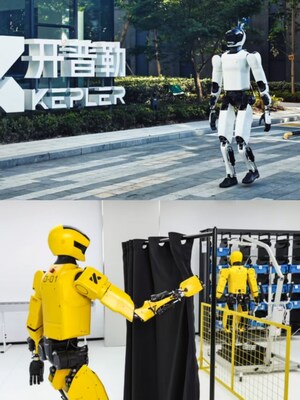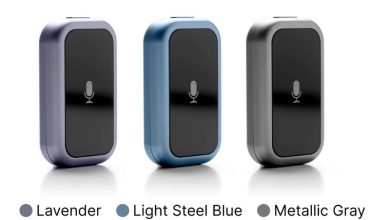
SHANGHAI, Sept. 11, 2025 /PRNewswire/ — Shanghai Kepler Robotics Co., Ltd. (“Kepler Robotics”) today announced the successful completion of a major gait upgrade for its humanoid robot K2 “Bumblebee,” and released China’s first demonstration video of a “hybrid-architecture disturbance-resistant” gait. In the video, K2 “Bumblebee” steadily navigates a variety of complex terrains—including bricks, plastic surfaces, and grass—and maintains stable steps even when subjected to external pushes, documenting the robot’s ability to maintain balance and adapt to real-world environments.
At the same time, Kepler introduced a demonstration of its VLA+ training platform, highlighting how K2 “Bumblebee” applies a layered VLA+ model to interpret natural language commands and carry out a wide range of tasks.
This dual upgrade in mobility and cognition positions K2 “Bumblebee” for future use across industrial applications, service scenarios, and a growing number of real-world deployments.
Committed to a Hybrid Architecture Based on Roller Screw Linear Actuators
K2 “Bumblebee” incorporates a hybrid design that combines roller screw linear actuators with rotary actuators in a series-parallel configuration, enabling a human-like straight-knee gait. This design pathway is widely acknowledged within the robotics sector as highly complex, requiring advanced kinematic modeling and precise torque control. The advantages, however, are clear: the approach delivers more natural gait, improves energy efficiency, strengthens task execution, and enhances adaptability across diverse environments. This methodology has also been recognized in the development roadmaps of other leading humanoid robotics firms.
Specifically, K2 “Bumblebee” is powered by planetary roller screw linear actuators working in tandem with rotary actuators. The linear actuators function as the robot’s “leg muscles,” providing the primary walking force, while the rotary actuators fine-tune adjustments and gait switching, enabling terrain adaptability. The planetary roller screw is a high-precision transmission component that converts rotary motion into linear motion through planetary drive and threaded engagement. It delivers high load capacity and precision transmission with an energy conversion efficiency of 81.3%. The roller screw also offers low friction, high positioning accuracy, and load-bearing strength superior to ball screws, ensuring smooth and durable operation.
Whether walking, executing tasks, or responding to natural language commands, Kepler’s K2 “Bumblebee” demonstrates reliable stability and accuracy—evidence that humanoid robots designed with hybrid architecture and roller screw linear actuators represent not only human-like form but also a pragmatic solution for efficiency and performance.
Overcoming Engineering Challenges to Achieve a Human-Like Straight-Knee Gait
Achieving a straight-knee gait using hybrid architecture and roller screw linear actuators presents engineering challenges in both mechanics and the transition from simulation to physical performance (the “Sim-to-Real Gap”).
Most commercially available robots built with quasi-direct-drive actuators rely on simpler serial structures. To ensure precise control of each K2 “Bumblebee” joint under heavy loads and complex motion, Kepler’s engineering team conducted extensive research into positional, velocity, and torque dynamics between roller screws and their paired joints. This work resulted in the development of a hybrid series-parallel structure. While the architecture introduces more complex kinematic and dynamic modeling, it enables K2 “Bumblebee” to achieve greater precision and stability.
The Sim-to-Real approach is the critical step in transitioning humanoid robots from prototypes to commercial systems. Yet the Sim-to-Real Gap introduces difficulties such as dynamic inconsistencies, sensor noise and latency, environmental variability, limitations in domain randomization, actuator delays and nonlinearities, as well as communication and computation lags—all of which complicate torque control during locomotion. For instance, simulations often rely on idealized ground models with uniform properties, while in practice, even surfaces of the same material can vary significantly in friction, elasticity, and other attributes. This discrepancy can cause gait strategies optimized in simulation to result in slippage or instability in real-world conditions.
Kepler Robotics has addressed these challenges by enabling K2 “Bumblebee” to dynamically switch gaits across complex terrains through a combination of reinforcement learning, imitation learning, and linear actuator torque control—producing a natural, human-like straight-knee walk. At the same time, Kepler trains the robot with simulated data to improve its general perception and language comprehension, while real-world datasets allow the system to directly learn from human movement. Through this dual-data flywheel of continuous learning, and with the layered VLA+ model supporting semantic recognition and task-oriented guidance for understanding, reasoning, and planning, K2 “Bumblebee” continues to improve its task execution reliability.
Expanding Steadily Into Real-World Application Scenarios
The latest gait upgrade of Kepler’s K2 “Bumblebee” not only confirms the progress of its hybrid architecture in humanoid gait control but also expands its real-world applicability. Commercial use cases include scientific research and education, exhibition and customer engagement, as well as data collection and training. Industrial deployments extend to logistics and material handling, intelligent manufacturing, and specialized operations. With the ability to operate across multiple sectors and supported by continuous learning and training, K2 “Bumblebee” is evolving into a versatile, capable operator in enterprise environments.
The year 2025 is widely viewed as the first year of humanoid robot commercialization. Looking ahead, the global humanoid robotics market will be shaped not only by hardware and algorithms, but also by ecosystems and scaled deployments. Companies that succeed in overcoming the barriers of cost and scalability will establish a clear competitive advantage. Kepler’s K2 “Bumblebee” is laying a strong foundation of competitive strengths in the humanoid robotics sector. These include its technology upgrades, multi-scenario adaptability, one-hour charging that supports up to eight hours of operation, a 30 kg payload capacity, more than 80% of hardware developed in-house, and best-in-class cost efficiency.
In recent years, robotics innovators in China have rapidly emerged as significant contributors to the industry’s growth. As the first commercially available humanoid robot to integrate a hybrid architecture with roller screw linear actuators, Kepler’s K2 “Bumblebee” is positioned to capitalize on its comprehensive commercial strengths in practical deployments, redefining production models across industries.
View original content to download multimedia:https://www.prnewswire.com/news-releases/kepler-robotics-announces-advanced-gait-upgrade-for-k2-bumblebee-demonstrating-the-potential-of-hybrid-architecture-302554233.html
SOURCE Shanghai Kepler Robot Co., Ltd.





